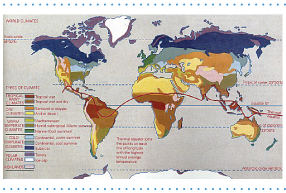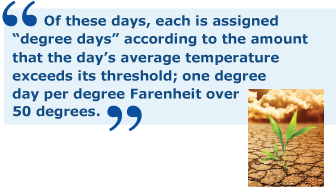|

Content Contributed by Anne Drummond, Imperial Beverage
 THE WINKLER SCALE THE WINKLER SCALE
The Winkler scale, sometimes known as the heat summation method, is a technique for classifying the climate of grape growing regions. In the system, geographical areas are divided into five climate regions based on temperature, known as Regions I through V.
Do you ever hear about a bottle of wine selling for $3000 and wonder what makes it so special? While part of the answer is subjective, another answer is the 1855 Classification of Bordeaux.
HOW THE WINKLER SCALE WORKS
Developed at the University of California, Davis by A. J. Winkler and Maynard Amerine, the system is based on the hypothesis that grapevines do not grow if the temperature is below 50 °F (10 °C). Days of growth in the specified growing region are hypothesized as follows:
Northern Hemisphere April 1-October 31
Southern Hemisphere October 1-April 30
Of these days, each is assigned “degree days” according to the amount that the day’s average temperature exceeds its threshold; one degree day per degree Fahrenheit over 50 degrees. Celsius may be used, but should be multiplied by 1.8 to convert to Fahrenheit degree days for the following list. All days in the locale are then added up, withthe sum used todetermine the region's classification as follows:
 2,500 degree days or fewer: Region I 2,500 degree days or fewer: Region I
2,501-3,000 degree days: Region II
3,001-3,500 degree days: Region III
3,501-4,000 degree days: Region IV
Greater than 4,000 degree days: Region V
The system is used officially in California, and other United States growing regions such as Oregon and Washington. It is less widely used elsewhere. However degree days can be computed for any location for which detailed climate data is available.
AREAS FOR CONCERN; LIMITATIONS
The climate regions of California only describe one aspect of an area's climate mean daily temperature. Many other important factors that contribute to a region's suitability for viticulture (and its terroir) areexcluded; among them sun exposure, latitude, precipitation, soil conditions, the likeliness of extreme weather, which might damage grapevines, and pollution. The climate regions are also macroscopic in nature; there is often a wide variety of microclimates in a given geographical area, and a region that has marginal grape-growing weather overall may have microclimates that produce excellent  grapes. A notable example is the Willamette Valley (firmly within region I), which was long regarded as too cold and wet to grow grapes, yet has vineyards planted on numerous south-facing hills in the rain shadow of the Coast range, which produce world-class Pinot Noir and many other excellent wines. grapes. A notable example is the Willamette Valley (firmly within region I), which was long regarded as too cold and wet to grow grapes, yet has vineyards planted on numerous south-facing hills in the rain shadow of the Coast range, which produce world-class Pinot Noir and many other excellent wines.
|
More complex climate indices have been introduced to address perceived shortcomings in the Winkler scale.
In viticulture, there are several levels of regional climates that are used to describe the terroir or immutable characteristics of an area. These levels can be as broad as a macroclimate, which includes entire wine regions or as small as a microclimate, which includes the unique environment around an individual grapevine. In the middle is the mesoclimate, which usually describes the characteristics of a particular vineyard site.
LEVELS:
Macroclimate, in viticulture, refers to the regional climate of a broad area such as an American Viticultural Area (AVA) or a French Appellation d'origine contrôlée (AOC). It can include an area on the scale of tens to hundreds of kilometers. On smaller scales are the related designations of mesoclimate and microclimate.
Mesoclimate refers to the climate of a particular vineyard site and is generally restricted to a space of tens or hundreds of meters.
Microclimate refers to the specific environment in a small restricted space-such as a row of vines. The more delineated term "canopy microclimate" refers to the environment around an individual grapevine.[1] Although many viticulturlists use the term "microclimate" when talking about an individual vine and the effects of canopy management.
|
